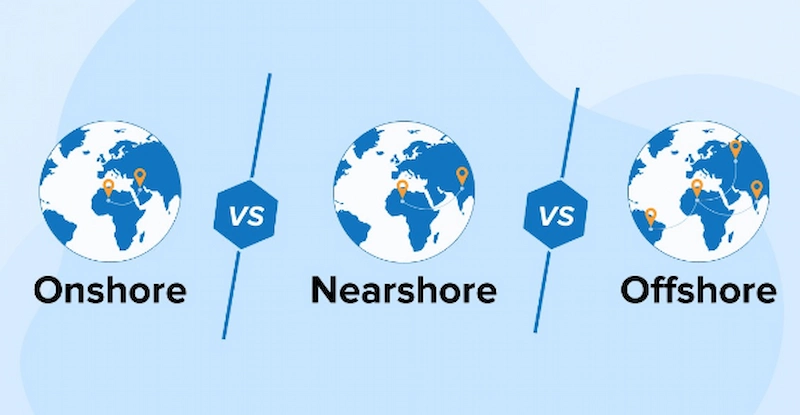Onshore vs. Nearshore vs. Offshore Outsourcing: Which One is Best for Your Business?
In the dynamic market your business should adopt well-executed strategies that not only boost your revenue but also improve your work efficiency. Today’s market demands a business that can channel into different aspects of operational excellence. Outsourcing is a unparallel opportunity for businesses to utilize top expertise. Whether a business is a small startup or a large corporation, outsourcing allows it to delegate certain tasks to external service providers, freeing up internal resources for core activities. In this article we will understand what the 3 types of outsourcing are, how they work, and which one is best for your business.
Understanding the Three Types of Outsourcing
Mainly outsourcing can be divided into 3 types: Onshore, Nearshore, and Offshore. Many companies Streamline Business Operations with Outsourcing expertise so, let’s understand the types of outsourcing.
Onshore Outsourcing
Onshore outsourcing, also known as domestic outsourcing, refers to hiring service providers within the same country where the company operates. This model is popular among businesses that require a high level of control, real-time collaboration, and adherence to local regulations.
Advantages
One of the key advantages of onshore outsourcing is ease of communication. Since businesses and service providers operate in the same time zone and share a common language, collaboration becomes seamless. Companies also benefit from having a workforce that understands local consumer behavior, compliance requirements, and industry standards.
Disadvantages
Despite all the advantages, onshore outsourcing tends to be the most expensive option. Labor costs in developed countries are significantly higher than in other parts of the world, making it a less attractive choice for businesses seeking cost efficiency. However, for industries that require stringent quality control, legal compliance, and cultural alignment, onshore outsourcing remains a viable choice.
Nearshore Outsourcing
Nearshore outsourcing involves delegating work to service providers in nearby or neighboring countries. Businesses opt for this model to strike a balance between cost savings and ease of communication. For example, U.S. companies often outsource to Mexico or Canada, while European businesses choose Eastern European countries like Poland or Ukraine.
Advantages
A major benefit of nearshore outsourcing is the minimal time zone difference, which ensures smoother communication and real-time project updates. Businesses can also save on travel expenses as nearshore destinations are easier to reach than offshore locations. Additionally, cultural similarities make it easier for employees and outsourced teams to collaborate effectively.
Disadvantages
Nearshore outsourcing reduces costs compared to onshore outsourcing; it is still more expensive than offshore outsourcing. Furthermore, businesses must carefully assess the skill levels and technological capabilities of nearshore service providers to ensure they meet industry standards.
Offshore Outsourcing
Offshore outsourcing refers to hiring service providers located in distant countries, often across continents. This model is chosen primarily for cost reduction, as labor is significantly cheaper in regions like India, the Philippines, and Vietnam compared to Western nations.
Advantages
The most significant advantage of offshore outsourcing is cost-effectiveness. Companies can access skilled professionals at a fraction of the cost of hiring domestically. This is particularly beneficial for labor-intensive tasks such as customer service, IT support, and software development.
Disadvantages
Offshore outsourcing comes with its own set of challenges. Time zone differences can lead to delays in communication and project execution. Additionally, language barriers and cultural differences can impact workflow efficiency. Businesses must also consider data security and regulatory compliance when outsourcing to a foreign country.
Choosing the Right Outsourcing Model

Selecting the best outsourcing model depends on various factors, including budget, business goals, operational complexity, and the nature of the tasks being outsourced. Here are some key considerations:
-
Budget Constraints
For businesses primarily looking to cut costs, offshore outsourcing is the most attractive option. Companies can access highly skilled professionals at a lower cost than in their home country. However, if budget constraints are not the main concern and a business prioritizes smooth communication and minimal risks, onshore or nearshore outsourcing may be preferable.
-
Communication and Time Zone Differences
If real-time communication and frequent collaboration are necessary, onshore or nearshore outsourcing is ideal. Time zone differences in offshore outsourcing can create delays in responses and project updates. Businesses that need immediate assistance or frequent meetings may struggle with offshore teams.
-
Complexity of the Task
The nature of the outsourced task also influences the decision. If the project requires frequent adjustments, close supervision, and deep industry knowledge, onshore or nearshore outsourcing is more suitable. Offshore outsourcing works well for standardized, repetitive tasks such as data entry, customer support, or backend development.
-
Legal and Regulatory Compliance
For industries with strict legal and regulatory requirements, such as healthcare and finance, onshore outsourcing is often the best choice. Domestic service providers are well-versed in local laws and can ensure compliance. Nearshore outsourcing may also work, provided the country has similar regulations. Offshore outsourcing, on the other hand, can pose risks if the country has weak data protection laws.
-
Cultural and Language Barriers
Cultural alignment plays a significant role in business success. When employees and outsourced teams share a similar work culture and communication style, collaboration is more effective. Onshore outsourcing provides the highest cultural alignment, followed by nearshore. Offshore outsourcing can sometimes lead to misunderstandings due to language barriers and different workplace norms.
The Future of Outsourcing
As the market is evolving companies are adopting different ways to accommodate the change. Many companies are considering hybrid mode that combines outsourcing strategies to maximize efficiency. Technology is also playing a crucial role in outsourcing decisions. The rise of automation, artificial intelligence, and cloud computing is making it easier for companies to manage outsourced teams, regardless of their location. Advanced communication tools like video conferencing, project management software, and instant messaging platforms are helping businesses overcome time zone and language barriers.
Conclusion
There is no one-size-fits-all solution when it comes to outsourcing. Each business has unique needs, and the choice between onshore, nearshore, and offshore outsourcing depends on various factors such as budget, communication requirements, complexity of tasks, and legal considerations. Finally, a business must understand and reevaluate their operational needs before making an outsourcing decision.
Visit the rest of the site for more interesting and useful articles.

